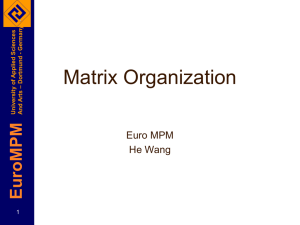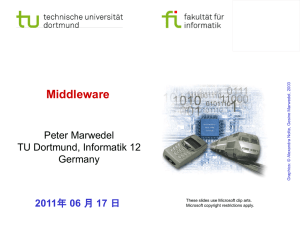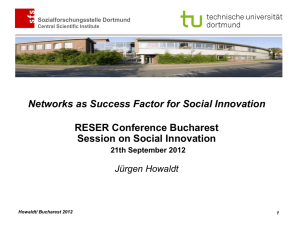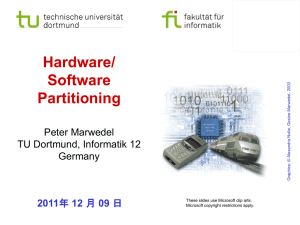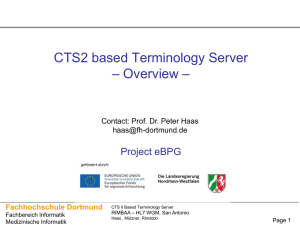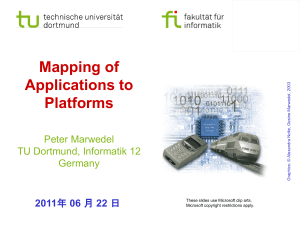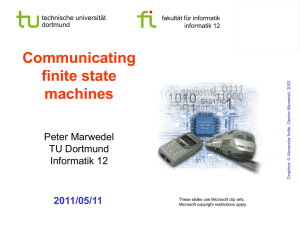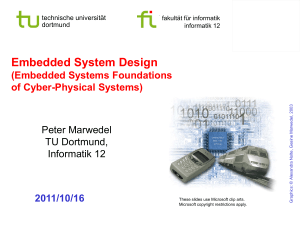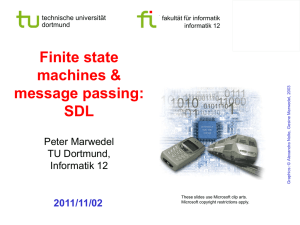es-marw-2-statecharts
advertisement
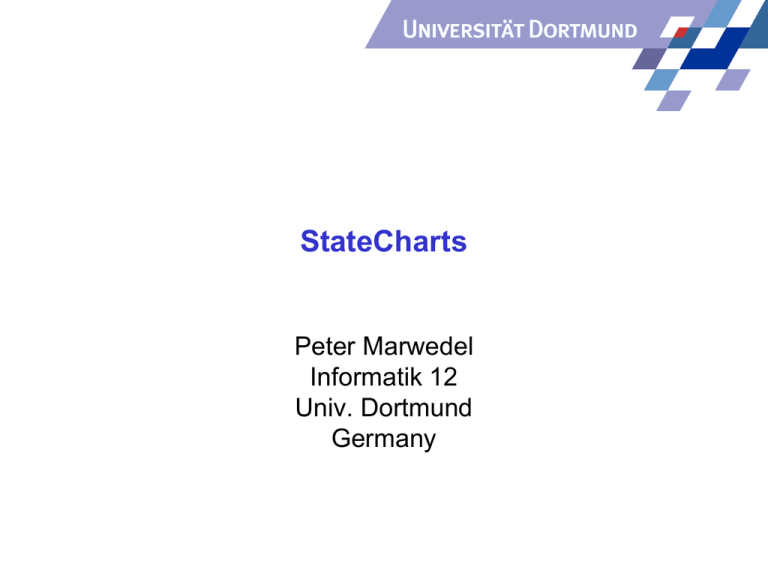
StateCharts
Peter Marwedel
Informatik 12
Univ. Dortmund
Germany
TU Dortmund
StateCharts
Used here as a (prominent) example of
a model of computation based on shared
memory communication.
appropriate only for local (nondistributed) systems
P. Marwedel, TU Dortmund, Informatik 12, 2007
- 2-
TU Dortmund
StateCharts: recap of classical automata
Classical automata:
input X
clock
Internal state Z
output Y
Next state Z+ computed by function
Output computed by function
• Moore-automata:
Y = (Z); Z+ = (X, Z)
• Mealy-automata
Y = (X, Z); Z+ = (X, Z)
Moore- + Mealy
automata=finite state
machines (FSMs)
Z0
0
e=1
P. Marwedel, TU Dortmund, Informatik 12, 2007
Z3
3
e=1
Z1
1
e=1
Z2
e=1 2
- 3-
TU Dortmund
StateCharts
Classical automata not useful for complex systems
(complex graphs cannot be understood by humans).
Introduction of hierarchy StateCharts [Harel, 1987]
StateChart = the only unused combination of
„flow“ or „state“ with „diagram“ or „chart“
P. Marwedel, TU Dortmund, Informatik 12, 2007
- 4-
TU Dortmund
Introducing hierarchy
FSM will be in exactly
one of the substates of S
if S is active
(either in A or in B or ..)
P. Marwedel, TU Dortmund, Informatik 12, 2007
- 5-
TU Dortmund
Definitions
Current states of FSMs are also called active states.
States which are not composed of other states are called
basic states.
States containing other states are called super-states.
For each basic state s, the super-states containing s are
called ancestor states.
Super-states S are called OR-super-states, if exactly
one of the sub-states of S is active whenever S is active.
superstate
ancestor state of E
substates
P. Marwedel, TU Dortmund, Informatik 12, 2007
- 6-
TU Dortmund
Default state mechanism
Try to hide internal
structure from outside
world!
Default state
Filled circle
indicates sub-state
entered whenever
super-state is entered.
Not a state by itself!
P. Marwedel, TU Dortmund, Informatik 12, 2007
- 7-
TU Dortmund
History mechanism
(behavior different
from last slide)
km
For input m, S enters the state it was in before S was left
(can be A, B, C, D, or E). If S is entered for the very first
time, the default mechanism applies.
History and default mechanisms can be used hierarchically.
P. Marwedel, TU Dortmund, Informatik 12, 2007
- 8-
TU Dortmund
Combining history and default state mechanism
same meaning
P. Marwedel, TU Dortmund, Informatik 12, 2007
- 9-
TU Dortmund
Concurrency
Convenient ways of describing concurrency are required.
AND-super-states: FSM is in all (immediate) sub-states of
a super-state; Example:
P. Marwedel, TU Dortmund, Informatik 12, 2007
- 10 -
TU Dortmund
Entering and leaving AND-super-states
incl.
Line-monitoring and key-monitoring are entered and left,
when service switch is operated.
P. Marwedel, TU Dortmund, Informatik 12, 2007
- 11 -
TU Dortmund
Types of states
In StateCharts, states are either
basic states, or
AND-super-states, or
OR-super-states.
P. Marwedel, TU Dortmund, Informatik 12, 2007
- 12 -
TU Dortmund
Timers
Since time needs to be modeled in embedded systems,
timers need to be modeled.
In StateCharts, special edges can be used for timeouts.
If event a does not happen while the system is in the left
state for 20 ms, a timeout will take place.
P. Marwedel, TU Dortmund, Informatik 12, 2007
- 13 -
TU Dortmund
Using timers in an answering machine
.
P. Marwedel, TU Dortmund, Informatik 12, 2007
- 14 -
TU Dortmund
General form of edge labels
event [condition] / reaction
Events:
Exist only until the next evaluation of the model
Can be either internally or externally generated
Conditions:
Refer to values of variables that keep their value until
they are reassigned
Reactions:
Can either be assignments for variables or creation of
events
Example:
service-off [not in Lproc] / service:=0
P. Marwedel, TU Dortmund, Informatik 12, 2007
- 15 -
TU Dortmund
The StateCharts simulation phases
(StateMate Semantics)
How are edge labels evaluated?
Three phases:
1. Effect of external changes on events and conditions is
evaluated,
2. The set of transitions to be made in the current step and
right hand sides of assignments are computed,
3. Transitions become effective, variables obtain new
values.
Separation into phases 2 and 3 guarantees deterministic
and reproducible behavior.
P. Marwedel, TU Dortmund, Informatik 12, 2007
- 16 -
TU Dortmund
Example
In phase 2, variables a and b are assigned to temporary
variables. In phase 3, these are assigned to a and b. As a
result, variables a and b are swapped.
In a single phase environment, executing the left state first
would assign the old value of b (=0) to a and b. Executing
the right state first would assign the old value of a (=1) to a
and b. The execution would be non-deterministic.
P. Marwedel, TU Dortmund, Informatik 12, 2007
- 17 -
TU Dortmund
Reflects model of clocked hardware
StateCharts using
StateMate semantics
is a synchronous
language.
In an actual clocked (synchronous) hardware system,
both registers would be swapped as well.
Same separation into phases found in other languages
as well, especially those that are intended to model
hardware.
P. Marwedel, TU Dortmund, Informatik 12, 2007
- 18 -
TU Dortmund
Steps
Execution of a StateMate model consists of a sequence of
(status, step) pairs
Status= values of all variables + set of events + current time
Step = execution of the three phases (StateMate semantics)
Status
phase 2
Other implementations of
StateCharts do not have
these 3 phases (and hence
are nondeterministic)!
P. Marwedel, TU Dortmund, Informatik 12, 2007
- 19 -
TU Dortmund
Other semantics
Several other specification languages for
hierarchical state machines (UML, dave, …)
do not include the three simulation phases.
These correspond more to a SW point of view
with no synchronous clocks.
LabView seems to allow turning the multiphased simulation on and off.
P. Marwedel, TU Dortmund, Informatik 12, 2007
- 20 -
TU Dortmund
Broadcast mechanism
Values of variables are visible to all parts of the
StateChart model
New values become effective in phase 3 of the
current step and are obtained by all parts of the
model in the following step.
!
StateCharts implicitly assumes a broadcast mechanism
for variables ( implicit shared memory
communication –other implementations would be very
inefficient -).
StateCharts is appropriate for local control systems (),
but not for distributed applications for which updating
variables might take some time ().
P. Marwedel, TU Dortmund, Informatik 12, 2007
- 21 -
TU Dortmund
Lifetime of events
Events live until the step following the one in which they
are generated („one shot-events“).
P. Marwedel, TU Dortmund, Informatik 12, 2007
- 22 -
TU Dortmund
Evaluation of StateCharts (1)
Pros:
Hierarchy allows arbitrary nesting of AND- and ORsuper states.
(StateMate-) Semantics defined in a follow-up paper to
original paper.
Large number of commercial simulation tools available
(StateMate, StateFlow, BetterState, ...)
Available „back-ends“ translate StateCharts into C or
VHDL, thus enabling software or hardware
implementations.
P. Marwedel, TU Dortmund, Informatik 12, 2007
- 23 -
TU Dortmund
Evaluation of StateCharts (2)
Cons:
Generated C programs frequently inefficient,
Not useful for distributed applications,
No program constructs,
No description of non-functional behavior,
No object-orientation,
No description of structural hierarchy.
Extensions:
Module charts for description of structural hierarchy.
P. Marwedel, TU Dortmund, Informatik 12, 2007
- 24 -
Some general properties of languages
Peter Marwedel
Informatik 12
Univ. Dortmund
Germany
TU Dortmund
1. Specifying timing (1)
4 types of timing specs required [Burns, 1990]:
• Measure elapsed time
Check, how much time has elapsed
since last call
?
execute
t
• Means for delaying processes
t
P. Marwedel, TU Dortmund, Informatik 12, 2007
- 26 -
TU Dortmund
2. Specifying timing (2)
• Possibility to specify timeouts
Stay in a certain state a maximum time.
• Methods for specifying deadlines
Not available or in separate control file.
execute
t
StateCharts comprises a mechanism for specifying
timeouts. Other types of timing specs not supported.
P. Marwedel, TU Dortmund, Informatik 12, 2007
- 27 -
TU Dortmund
2. Properties of processes (1)
•
Number of processes
static;
dynamic (dynamically changed hardware architecture?)
•
Nesting:
Nested declaration of processes
process {
process {
process {
}}}
or all declared at the same level
process { … }
process { … }
process { … }
P. Marwedel, TU Dortmund, Informatik 12, 2007
- 28 -
TU Dortmund
2. Properties of processes (2)
•
Different techniques for process creation
Elaboration in the source (c.f. ADA, below)
declare
process P1 …
explicit fork and join (c.f. Unix)
id = fork();
process creation calls
id = create_process(P1);
StateCharts comprises a static number of processes,
nested declaration of processes, and process
creation through elaboration in the source.
P. Marwedel, TU Dortmund, Informatik 12, 2007
- 29 -
TU Dortmund
3. Using non-standard I/O devices -
Direct access to switches, displays etc;
No protection required; OS can be much faster than
for operating system with protection.
No support in standard StateCharts.
No particular OS support anyhow.
P. Marwedel, TU Dortmund, Informatik 12, 2007
- 30 -
TU Dortmund
4. Synchronous vs. asynchronous languages (1)
Description of several processes in many languages nondeterministic:
The order in which executable tasks are executed is not
specified (may affect result).
Synchronous languages: based on automata models.
„Synchronous languages aim at providing high level,
modular constructs, to make the design of such an
automaton easier [Halbwachs].
Synchronous languages describe concurrently operating
automata. „.. when automata are composed in parallel, a
transition of the product is made of the "simultaneous"
transitions of all of them“.
P. Marwedel, TU Dortmund, Informatik 12, 2007
- 31 -
TU Dortmund
4. Synchronous vs. asynchronous languages (2)
Synchronous languages implicitly assume the presence of a
(global) clock. Each clock tick, all inputs are considered,
new outputs and states are calculated and then the
transitions are made.
This requires a broadcast mechanism for all parts of the
model.
Idealistic view of concurrency.
Has the advantage of guaranteeing deterministic behavior.
P. Marwedel, TU Dortmund, Informatik 12, 2007
- 32 -
TU Dortmund
Summary
StateCharts as an example of shared memory MoCs
AND-states
OR-states
Timer
Broadcast
Semantics
• multi-phase models
• single-phase models
Some general language properties
Process creation techniques,
asynchronous/synchronous languages
P. Marwedel, TU Dortmund, Informatik 12, 2007
- 33 -
